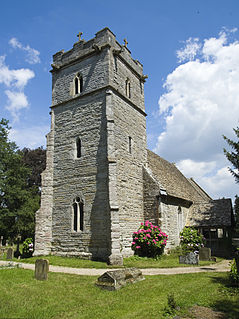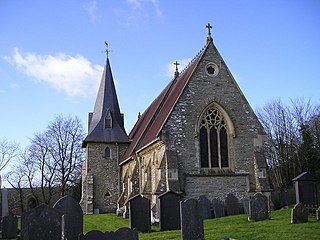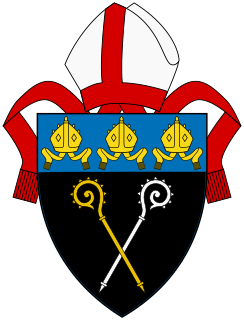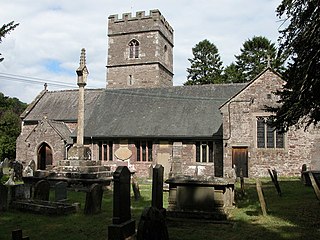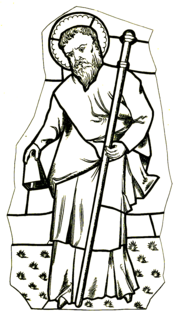| Saint Dyfan | |
|---|---|
 SS Dyfan & Teilo's in Merthyr Dyfan | |
| Martyr | |
| Canonized | Pre-Congregation |
| Feast | Usually unobserved |
| Patronage | Merthyr Dyfan Llandyfan |
Saint Dyfan is a highly obscure figure who was presumably the namesake of Merthyr Dyfan ("martyrium of Dyfan") and therefore an early Christian saint and martyr in southeastern Wales in Roman or Sub-Roman Britain. [1] He is sometimes styled the protomartyr of Wales. The erection of his martyrium was credited to the 6th-century St Teilo. In the 19th century, Edward Williams conflated him with St Deruvian, a figure in the legendary accounts of the baptism of King Lucius of Britain. The discovery of Williams's alterations and forgeries have since discredited this connection. [2] Partially based on this connection, however, the church of Merthyr Dyfan dates his martyrdom to c. 180.

Merthyr Dyfan or Dyfan is a northeastern suburb of Barry in the Vale of Glamorgan, in south Wales, formerly an independent medieval village. It is also an ecclesiastical parish and a formal electoral ward of the Vale of Glamorgan. It borders Colcot to the west, Buttrills to the southwest and Gibbonsdown to the southeast. Its main roads are Merthyr Dyfan Road, a hilly road leading down from the A4050 road which leads into Wenvoe and Cardiff; and Skomer Road which separates it from Gibbonsdown and eventually also leads to the A4050 road. Merthyr Dyfan contains an old parish church, Barry Rugby Club, Bryn Hafren Comprehensive School and the Master Mariner Pub and Holm View Leisure Centre, although the last two could be considered to be in northern Gibbonsdown. Watercolour artist Thomas Frederick Worrall lived in Barry from 1913 and painted several scenes of Merthyr Dyfan. A depiction of Merthyr Dyfan Road, viewed from where the road curves and looking towards the coast, has been deposited at the National Library of Wales. It is to be digitised and made available on their web site. The Church in Wales has a small painting of his of the church.

A martyrium (Latin) or martyrion is a church of a specific architectural form, centered on a central element and thus built on a central plan, that is, of a circular or sometimes octagonal or cruciform shape.
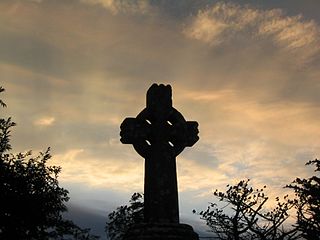
Celtic Christianity or Insular Christianity refers broadly to certain features of Christianity that were common, or held to be common, across the Celtic-speaking world during the Early Middle Ages. "Celtic Christianity" has been conceived of with differing levels of specificity: some writers have described a distinct "Celtic Church" uniting the Celtic peoples and distinguishing them from the "Roman" Catholic Church, while others classify it as simply a set of distinctive practices occurring in those areas. Scholars now reject the former notion, but note that there were certain traditions and practices used in both the Irish and British churches but not in the wider Christian world. These include a distinctive system for determining the dating of Easter, a style of monastic tonsure, a unique system of penance, and the popularity of going into "exile for Christ". Additionally, there were other practices that developed in certain parts of Britain or Ireland, but which are not known to have spread beyond a particular region. The term therefore denotes regional practices among the insular churches and their associates, rather than actual theological differences.
Contents
His feast day does not appear in any medieval Welsh calendar of the saints and is not presently observed by the Anglican, Catholic, or Orthodox churches in Wales.
A Gŵyl Mabsant, also known as the Patronal Festival or Wake of a parish, is a traditional Welsh festival held annually in commemoration of the patron saint of a parish. Prior to 1752, the corresponding fair was reckoned by the Saint's Day according to tradition or to the official Catholic or Anglican Calendar of Saints; following the shift to New Style dating, however, the fair was reckoned eleven days later. By the 19th century, the fair often began on the following Sunday and then lasted between three days and a week.

The Church in Wales is the Anglican church in Wales, composed of six dioceses. It defines itself as "the ancient Church of this land, catholic and reformed. It proclaims and holds fast the doctrine and ministry of the one, holy, catholic and apostolic Church". In 2017, the Church in Wales reported 210,000 attendees in its membership statistics. The Anglican church is the largest denomination in Wales.
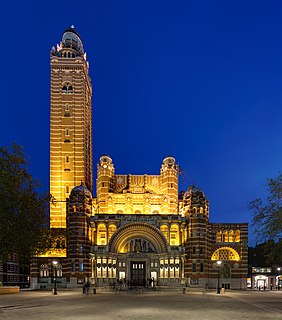
The Catholic Church in England and Wales is part of the worldwide Catholic Church in full communion with the Pope. It traces its history to the apostles through Catholic Christendom, the Western Latin Church, particularised and recorded in Roman Britain as far back as the 1st century. Later, in the 6th century, the church was judicially bonded to the Apostolic See of Rome, when Gregory the Great through his Benedictine and Roman missionary, Augustine of Canterbury, established a direct link from the Kingdom of Kent to the Holy See in 597 AD. This ancient link to Irenaeus's source of Christian guidance, the See of Rome, has enriched its inter-church identity, not only across Britain and continental Europe but also and especially globally within what is sometimes referred to as the "Catholic Communion of Churches".
